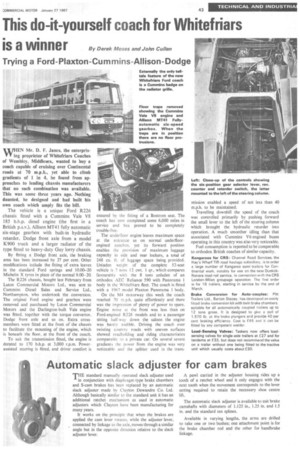This do-it-yourself coach for Whitefriars
Page 45

If you've noticed an error in this article please click here to report it so we can fix it.
is a winner By Derek Moses and John Cullen
Trying a Ford-Plaxton-Cummins-Allison-Dodge
EN Mr. D. F. Janes, the enterpris
ing proprietor of Whitefriars Coaches of Wembley, Middlesex, wanted to buy a coach capable of cruising over Continental roads at 70 m.p.h., yet able to climb gradients of 1 in 4, he found from approaches to leading chassis manufacturers that no such combination was available. This was some three years ago. Nothing daunted, he designed and had built his own coach which amply fits the bill.
The vehicle is a unique Ford R226 chassis fitted with a Cummins Vale V8 185 b.h.p. diesel engine (the first in a British p.s.v.), Allison MT41 fully automatic six-stage gearbox with built-in hydraulic retarder, Dodge front axle from a model K900 truck and a larger radiator of the type fitted to heavy-duty Guy lorry chassis.
By fitting a Dodge front axle, the braking area has been increased by 27 per cent. Other modifications include the fitting of extra leaves in the standard Ford springs and 10.00-20 Michelin X tyres in place of the normal 9.00-20.
The R226 chassis, bought last February from Luton Commercial Motbrs Ltd., was sent to Cummins Diesel Sales and Service Ltd., Northampton, who undertook the conversion. The original Ford engine and gearbox were removed and purchased by Luton Commercial Motors and the Darlington-built Vale engine was fitted, together with the torque convertor, Dodge front axle and so on. Extra crossmembers were fitted at the front of the chassis to facilitate the mounting of the engine, which is beneath the floor, at the front of the coach.
To suit the transmission fitted, the engine is dcrated to 170 b.h.p. at 3,000 r,p.m. Powerassisted steering is fitted, and driver comfort is ensured by the fitting of a Bostrom seat. The coach has now completed some 6,000 mites in service and has proved to be completely trouble-free.
The underfloor engine leaves maximum space at the entrance as on normal underfloorengined coaches. yet its forward position enables the provision of maximum luggage capacity in side and rear lockers, a total of 248 cu. ft. of luggage space being provided, Unladen weight of the complete 52-seat vehicle is 7 tons 12 cwt. 1 qr., which compares favourably with the 8 tons unladen of an orthodox AEC Reliance 590 with Panorama 1 body in the Whitefriars fleet. The coach is fitted with a 1967 model Plaxton Panorama 1 body.
On the M4 motorway this week the coach reached 70 m.p.h. quite effortlessly and there was the impression of plenty of power to spare. Engine noise at the front was less than on Ford-engineci R226 models and to a passenger sitting half way down the saloon the engine was barely audible. Driving the coach over twisting country roads with uneven surfaces showed roadholding and riding characteristics comparable to a private car. On several severe gradients the power from the engine was very noticeable and the splitter used in the trans
mission enabled a speed of not less than 40 m.p.h. to be maintained.
Travelling downhill the speed of the coach was controlled primarily by pushing forward the small lever to the left of the steering column which brought the hydraulic retarder into operation. A much smoother idling than that associated with Cummins V6-engined buses operating in this country was also very noticeable.
Fuel consumption is reported to be comparable to orthodox British coaches of similar capacity.
Kangaroos for CRS: Channel Road Services. the Hay's Wharf TIP road haulage subsidiary, is to order a large number of Kangaroo semi-trailers for Continental work, notably for use on the new DunkirkNovara road-rail service, in connection with the CRS London-Milan groupage operation. The first order is for 18 trailers, starting in service by the end of March.
Brake •Conversion for Auto-couples: Pitt Trailers Ltd., Barton Stacey, has developed an easily fitted brake conversion kit with twin brake chambers, suitable for all automatically coupled trailers up to 12 tons gross. It is designed to give a pull of ',570 lb. at the brake plungers and provide 40 per cent braking efficiency, Cost is 45 and it can be fitted by any competent welder.
Load-Sensing Valves: Taskers now offers loadsensing valves for single-axle trailers at £27 and for tandems at £33, but does not recommend the valve on a trailer without one being fitted to the tractive unit which usually costs about £30.












































































































